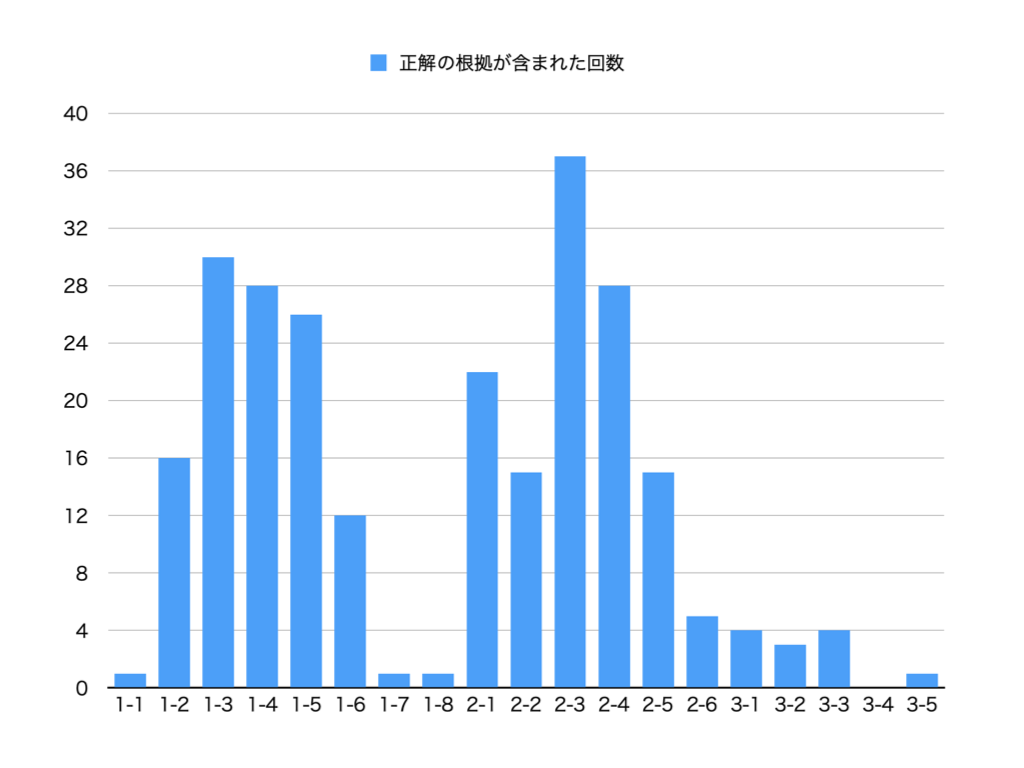Contents
目的
英検1級リスニングの大問2の内容一致問題は、リスニング問題の中でも最も正答率が低く、難しいと言われています.
本記事では大問2を攻略するために私が分析した内容をご紹介させていただきます.
英検1級リスニング大問1の分析結果を以下にまとめているのでこちらもチェックしてみて下さい.
 【英検1級】リスニング大問1リサイクル問題について分析してみた
【英検1級】リスニング大問1リサイクル問題について分析してみた
分析結果

分析対象
分析対象は、2012年度第3回から2020年度第3回までの合計25回分の過去問としました.
さらに遡って対象データを広げると分析結果は変わる可能性がある旨は予めご了承ください.
正解の根拠となる情報がアナウンスされるタイミング
大問2は主に前半と後半の2パラグラフで構成され、1つ目の質問に対する答えが放送の前半で、2つ目の質問に対する答えが放送の後半でアナウンスされます.
また2パラグラフ構成に比べると頻度は少ないですが、前半、中盤、後半の3パラグラフ構成というパターンもあります.
以下は25回分の合計125問の大問2でどのタイミングで正解の根拠となる情報がアナウンスされているかを調べた結果で、例えば1-3とは第1パラグラフの3文目という意味になります.

リスニング大問2でどこで正解の根拠となる情報がアナウンスされているか
上記棒グラフから以下のことがわかります.
- 1問目の正解の根拠となる情報は第1パラグラフの3文目から5文目でアナウンスされることが多い
- 2問目の正解の根拠となる情報は第2パラグラフの3文目から4文目でアナウンスされることが多い
- リスニングの一番最初の文や終盤などでは正解の根拠となる情報がアナウンスされることは稀である
正答率を上げるためには
大問2を攻略するために重要なことは2点で、英語を聞き取る力の向上と言い換えに慣れることです.
1. 英語を聞き取る力の向上
これはリスニングなのである意味当たり前ですが、英語の音声を適切に聞き取り内容を理解する力です. この力を伸ばすためにはスクリプトを見ながら音声を聞いてみる、音読してみる、シャドーイングしてみるといった学習方法が有用でしょう.
詳細は別記事にまとめているのでこちらもチェックしてみて下さい.
2. 言い換えに慣れる
2つ目は同じ事象や事柄を違う単語や表現を用いる、いわゆる「言い換え」に慣れることが重要になります.
リスニング大問2では本文と選択肢ではほぼ100%言い換えが入ります.
そのため、リスニング大問2の復習時には言い換えに注目して、言い換えに慣れることが重要になります.
次の章で大問2で複数回出題された言い換えについてご紹介します.
言い換えについて

言い換えパターン
ここでは具体的にこれまでの問題で複数回使われた言い換えパターンについて具体的にご紹介します.
「防ぐ、妨害する」
- protect retina from damage → prevent damage to the retina
- prevent – from being released → prevent the release
- prevent the passage of envorinomental protection laws → be reluctant to pass them
- prevent the parasite from navigating to the mosquito’s mouth → keeping the parasite out of mosquito’s mouths
- have beneficial bacteria that protected them from infection → hosting organisms that prevent fungal diseases
- preventing erosion by rivers → prevent soil from being washed away
- impair their function → prevent from working properly
- blocking a chemical essential for muschle movement → preventing a chemical neurotransmitter from being released
- block the creation of blood vessels → prevent the flow of blood
「正確な」
- they are more accurate than current maps → they are less precise than maps
- the wording is anything but precise → unclear wording
「避ける」
- supporters view such implanted devices as inevitable → they are unavoidable in future workplaces
- has extremely low student debt → avoid high debt
- unavoidable collisions → emergencies
- maps hat show trouble spots to avoid → help people stay away from potentially dangerous areas
- should refrain from eating → should avoid consuming
「確認する、特定する」
- opprtunies to identify new species → the chances of finding new species
- indentify dangerous bacteria → investigate the types of bacteria
- If S were detected, it could help them in the fight against crime → identify threats to public safety
- identifying exactly where in the supply chain a problem occurred → to better identify sources of food contamination
- give many false alerts → often mistakenly identify items
- detect these changes → monitor the gases
「有効な」
- to demonstrate that their innovations are effective → to see if they can be commercially viable
- have become increasingly resistant to antibiotics → have become less effective
- could only be obtained at close range → not effective from a distance
- increase its effectiveness → more powerful
- proven medical treatments → effective treatments
言い換えパターンに慣れるには
言い換えに慣れるには、まずは過去問を解いた後、本文と選択肢でどのように言い換えがおこなわれているかを意識して復習することが重要です.
また日頃の英単語学習では単語と日本語訳だけでなく、英英辞典や類語辞典(シソーラス)を活用して英語で英単語の意味や類義語などの学習を合わせて取り組むことが有効です.


